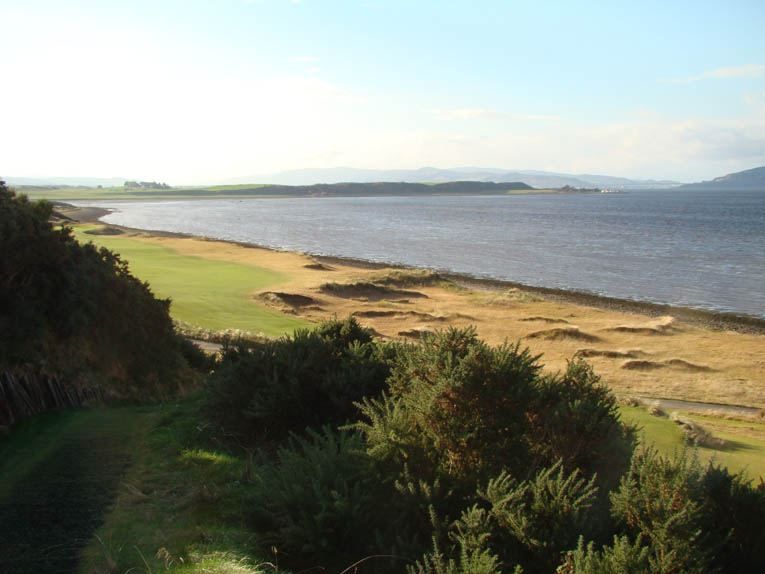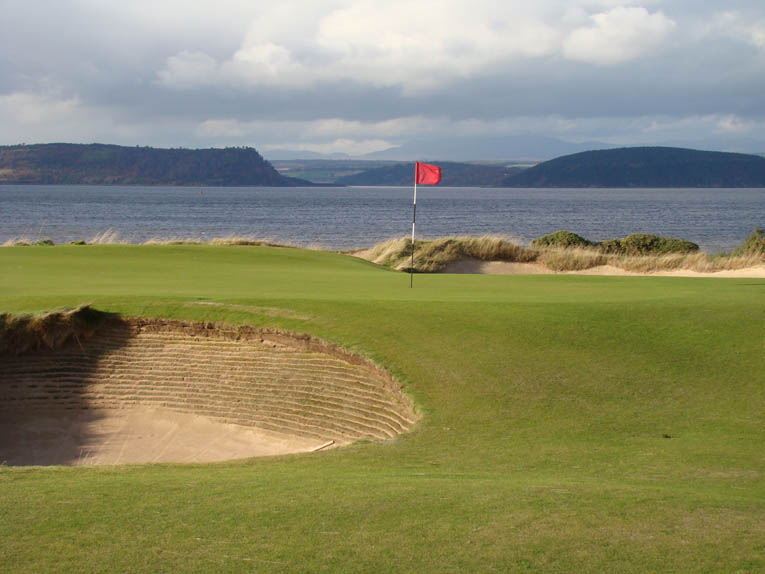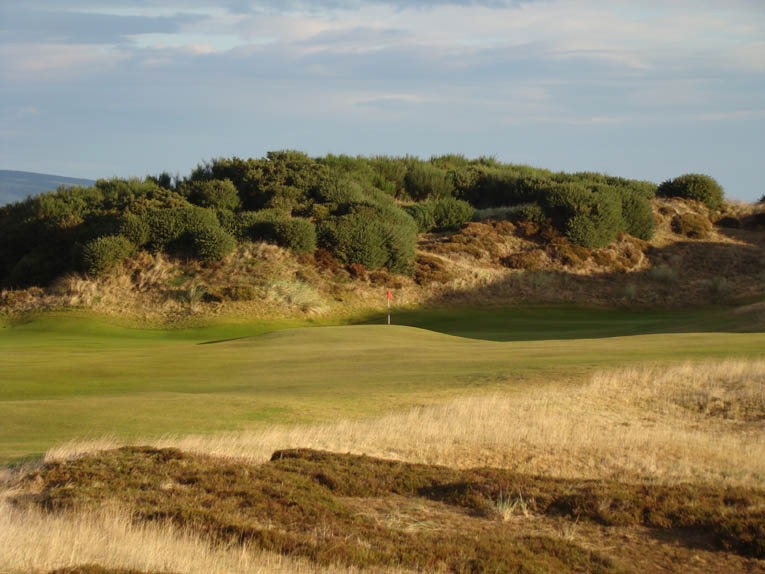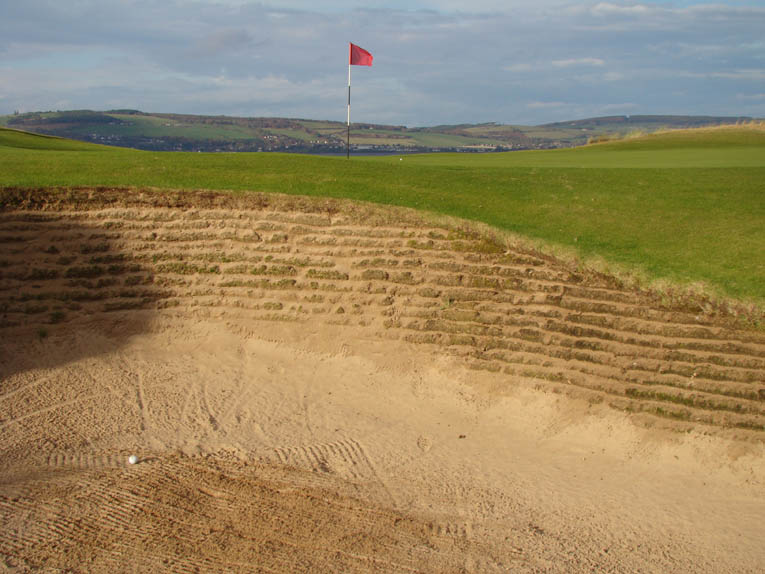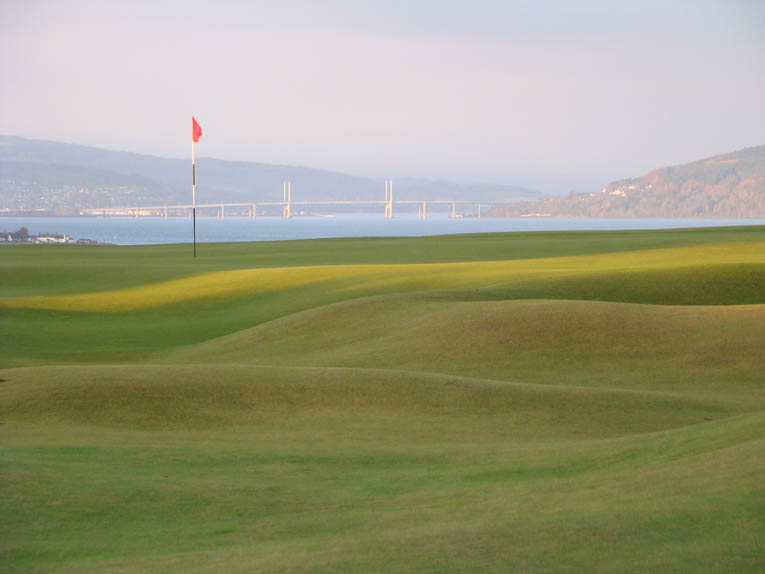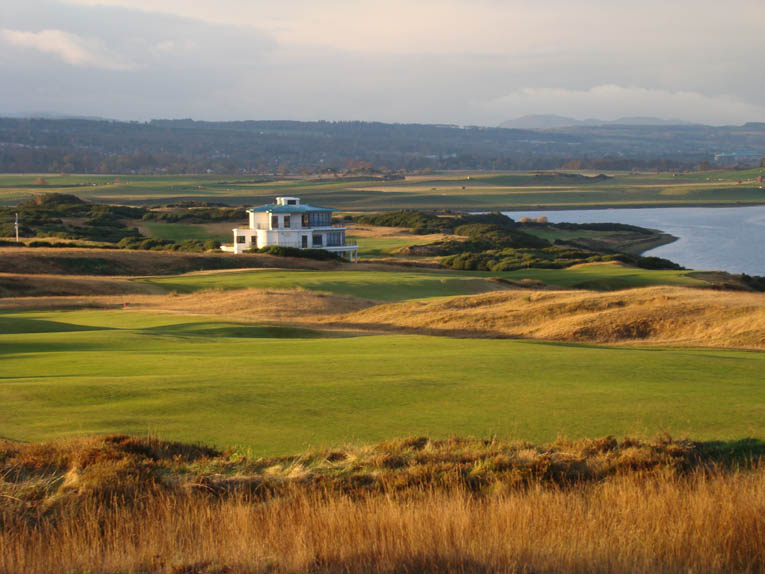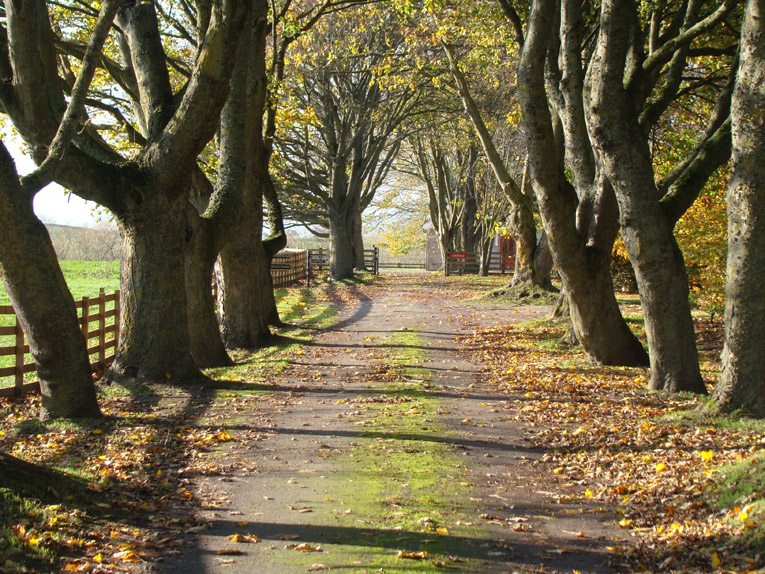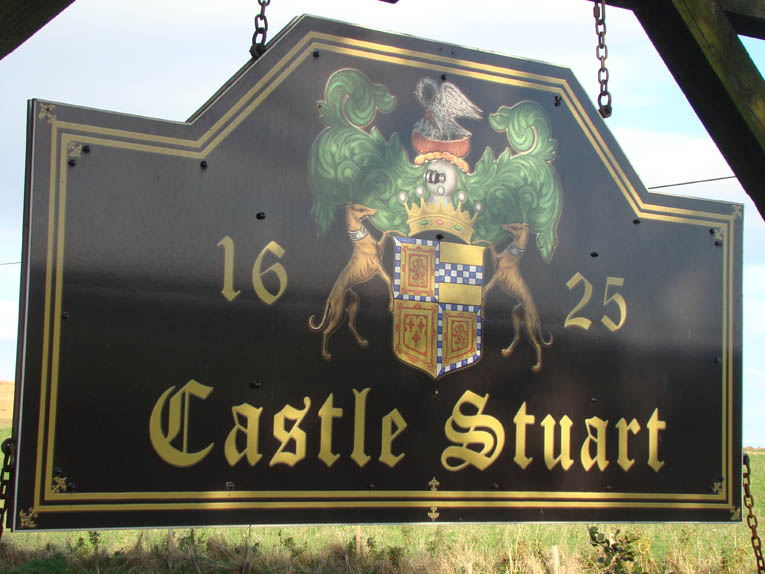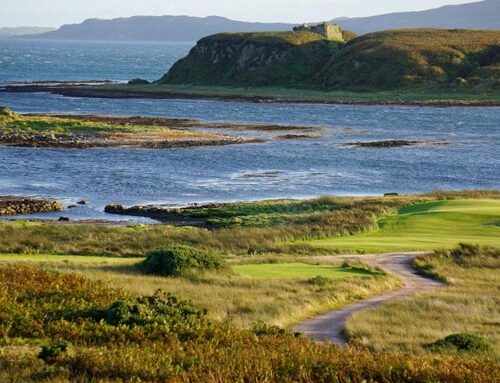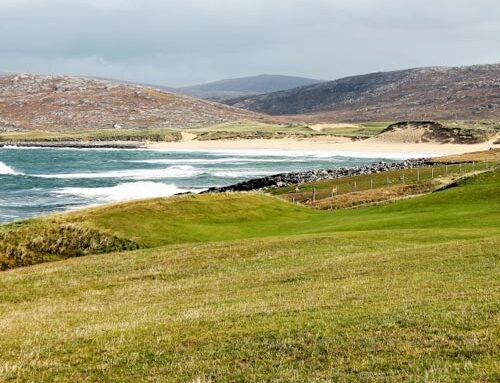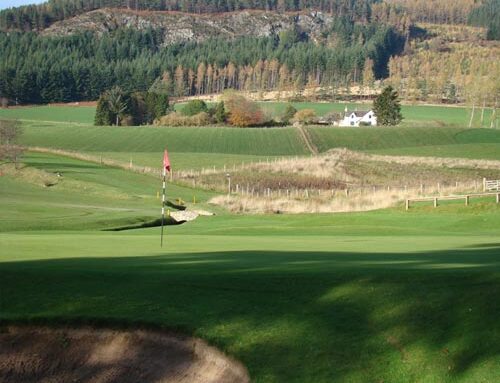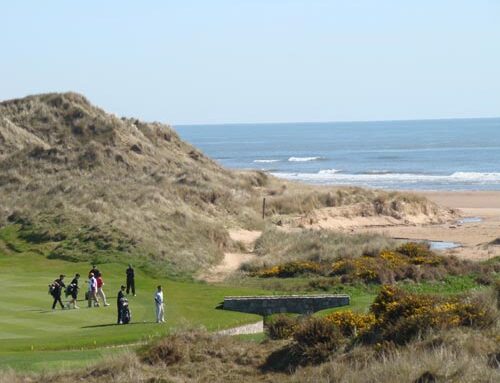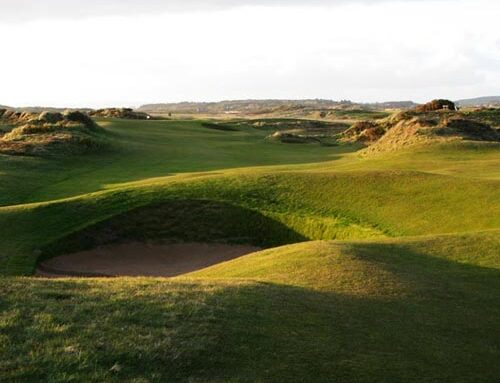Castle Stuart Golf Links
Inverness, Scotland, United Kingdom
Golf courses don’t exist in a vacuum. They are part of a club, a resort, a municipality or some organization. Their creation is usually high-minded and purposeful but those founding principles are often diluted if not abandoned over time. Sometimes the course is created for a lesser purpose; to sell real estate, attract guests to a spa. In the modern game, Castle Stuart is exemplary in that it stands for a very particular and precisely defined brand of golf. The visionary Mark Parsinen created it and his welcoming remarks found on the first three pages of the Castle Stuart yardage book are illuminating. The course itself and his noble words, ‘Castle Stuart itself reflects an appreciation that the game of golf is more about error and recovery than it is about perfection. Its ethos is more about redemption than punishment’ are cause for celebration.
Of course, the reason that the statement is so appealing is that it treats golf as a game from which pleasure is derived. Somewhere, somehow the message of Alister McKenzie’s ‘pleasurable challenge’ was lost. Likely it occurred because of the pause in golf course construction owing to the Great Depression and World War II. When course construction resumed, the world had become a more sober place and it became fashionable for golf to be a test, the more strenuous, the better. The dreaded benchmark of ‘7,000 yards’ and the awful cliché ‘a championship course’ became reality. Instead of routinely playing in 2 1/2 hours at courses like Swinley Forest or Westward Ho!, the new norm swelled to 4 1/2 hours. After a few decades of such penance, the growth of golf stalled. If people wanted to get beat up, they stayed at work.
Happily, a band of architects came along in the 1990s with a better understanding, one that appreciated the Golden Age architecture of the 1920s. One of those leaders was Mark Parsinen, whose 1996 book Golf as it Should Be is one of the best – and hardest to find – manifestos of the game. His chapter titles in bold below and words echo ancient sentiment, define challenge and shout for reform:
Golf – The fun of golf is of an absorbing nature and is therefore addictive as a respite.
Hazards – The absorbing nature of golf derives from problems and solutions that arouse keen interest and hopefulness.
Nature – The most beautiful, interesting and therefore stimulating hazards are those of nature.
Undulation – Contours can be the most obvious of problems yet are too often ignored causing annoyance rather than interest.
Subtlety – Straightforward problems and solutions are often not as absorbing as those which are more subtle.
Variety – Keen interest is sustained when problems and solutions, real or apparent, are ever changing.
Nuance – The texture of the course should reward strategy, not demand perfection.
Tee shots – Problems can be solved from the beginning or by working back from the end.
Greensites – Approach problems with multiple solutions lead to absorbing interest and pleasure.
Fairness – Luck along with keen interest and hopefulness for all classes of golfer underlie the essential fun of the game.
Clubhouse – One’s experience will be complete and fulfilling when the fun of the course is absorbing and the fun of the clubhouse releasing.
Well said! Yet, writing and getting it done in the field are two different things. The only sure way to achieve your vision is to be the developer and to control the entire process. In the late 1990s, Parsinen famously worked with Kyle Phillips and developed Kingsbarns, six miles outside of St. Andrews. For starters, the climate was perfect for fescue grasses that allow the ground game/shot options to flourish. The design itself featured greens averaging nearly 11,000 square feet and gave golfers what they actually want: a course beside a large body of water. Like The Old Course at St. Andrews, it’s a place where a player can hit more greens in regulation (and likely take more putts) than at his home course. Not surprisingly the popularity of the course soared.
A few years on Parsinen cast his eyes across the Scottish landscape for another opportunity. He looked at the large dunes north of Aberdeen that later became the Trump course but working in such dunes came with restrictions and while majestic, the dunes inhibited views of the sea. Ultimately, he came across a 605 acre parcel of land outside of Inverness along the Moray Firth. He took his friend and Kingbarns General Manager Stuart McColm to have a look. McColm saw the potential for links golf that Parsinen envisaged. One merit was that the bloc of land faced west, meaning that it was sheltered from the harshest North Sea winds and warmed by the afternoon sun. More importantly, the sandy soil was ideal for golf as it was neither too fine nor too uniform. It would allow water to drain at a rate satisfactory for the growth of straight fescue. Meanwhile, the east/west axis of the shoreline provided views of four famous landmarks in the region: Kessock Bridge, Fort George (home of the Black Watch), Chanonry Lighthouse, and Castle Stuart, which dates to 1625.
Like Kingsbarns, Parsinen sought a co-architect to bounce ideas off and to execute the in-the-dirt detailing that would nuance the course into a rumpled links. Hot off the uber successful Rustic Canyon in Parsinen’s home state of California, Gil Hanse and his design associate Jim Wagner became the logical selection. Greenkeeper Chris Haspell completed the development team and told the story in our October 2013 Feature Interview:
I got a call out of the blue from Stuart McColm, I knew Stuart, the super at Kingsbarns and we were both managing fescue. Stuart had constructed 8 or 9 courses and I had designed and constructed several myself, all pure Fescue, easy to maintain and fun to play. I had also been lucky enough to have shaped several others in Denmark working with some good architects. However, the emphasis was on difficulty, which was the opposite to my personal design philosophy. He asked if I wanted to see the site and hear about the project. He explained that they wanted to learn from the lessons at Kingsbarns and produce a challenging but fun golf course. I saw the site and I was hooked. As soon as he said it was Mark, Gil and Jim, he really got my attention. I had heard about Gil from Rustic Canyon and Crail and I knew Mark had developed Kingsbarns with Stuart, chances to work with a team like that only come along once in a lifetime so I jumped at it. Once we had our first meeting with Gil, Mark, Jim, Stuart and myself, I knew we were going to have a lot of fun and had the potential to produce something quite special.
With the design team in place the property was surveyed, its assets and difficulties defined. Ultimately success would depend on these challenges; how to use the 2,950 yard strip of land along the Moray Firth, how those holes would connect with ones on the upper plateau and how to imbue the largely flat landscape with links qualities? It was imperative that the solutions found embody the defining principles of its visionary as enunciated in the yardage guide:
The texture of recovery issues after the inevitable error is an important characteristic that often defines the personality of a golf course. How engaging are the recovery circumstances? Is there variety to the type of issues encountered? Are there interesting options available? Can a player demonstrate skill with his recoveries? Do the issues favor one class of player more than another? Does judgment in light of personal tendencies matter in regard to the decisions taken? And perhaps most importantly, do the circumstances elicit hope that something good can yet happen despite the compromised situation? And as a result, is each and every golfer as pleasurably absorbed as possible, errors or not?
Achieving such grand ideals is no easy matter and the design team considered and discarded countless iterations along the way. Let’s take the one shot eleventh as a specific example. Once it was determined that a par 3 should precede a par 5 and not vice-versa, the issue became how to build a compelling short hole while staying within the defined ethos of the course. Preliminary plans had the green walled off with bunkers and pressed from behind by the firth, creating the sort of exacting target expected on a sub-150 yard hole. Yet, the rub was options didn’t exist and weaker players would likely muddle about in one of the fronting bunkers, haplessly trying to execute a soft splash shot. Forcing the less accomplished player into such a compromised position was hardly in keeping with the lofty goals.
Ultimately, a single revetted bunker was placed front left and complemented with a mass of short grass right. It would offer a wider variety of plays, some of which would be more daunting for the good player. Tight fescue requires a precise strike from a player attempting a deft recovery while the average golfer can just grab his putter. Balancing the needs of all golfers is evident throughout the design with the tiger being given the ability to showcase recovery skills while the lamb contentedly moves to the next tee with a bogey.
Additionally, the general layout of Castle Stuart is a role model. The distinctive clubhouse sits back enough from the water to allow room for the 30,000 square foot practice putting green to occupy prime space. The starter’s hut is beside the green and after a warm greeting from Tom, the golf commences in blissful seclusion. The ample first fairway and open green encourage all golfers to get away in a nice, orderly manner.
Holes to Note
(Both the 7,000 yard and 6,555 yard tees are listed below).
Second hole, 550/530 yards; The first three holes on each nine are laid across a narrow strip of land sandwiched between the cliff and shoreline. This reachable par 5 is the cornerstone of the opening trio that was artfully constructed in a manner to break up any sense of linearity. Behind the first green and as part of the second tee complex, a 30 foot mound was built to provide counterpoint. The long second fairway is split, bends left and ultimately right so that the green complex seemingly protrudes into the firth. A final tweak was the placement of the third tee benched high into the hillside so that the hole angles toward the water rather than merely playing along it. Stunning views are afforded by these clever design ploys and three diverse holes fabricated in what was initially a confined space.
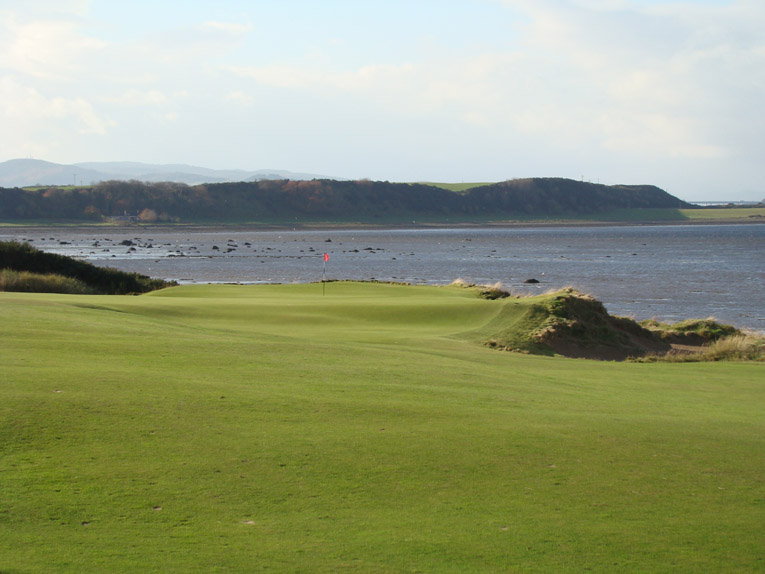
Let’s examine the second green complex. Note how the architects canted it from front left to back right. Ten of the eighteen flags at Castle Stuart generally feature sky or water as a backdrop. Typical of the design, the green is bunkered on only one side and tight turf feeds into it.
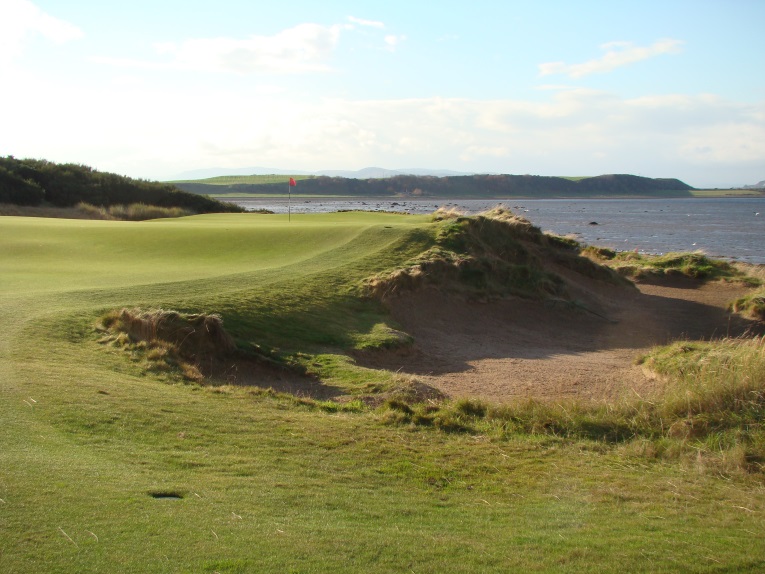
The front lower tier provides the more easily accessed hole locations. The green is massive, some 60 paces in length.

This golfer tries to recover from the right greenside bunker where nature and man’s hand are indistinguishable.
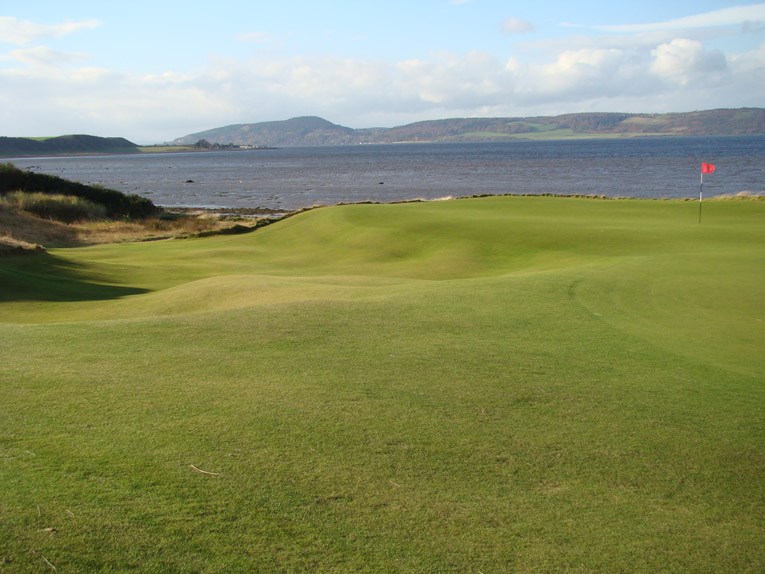
The green is bulbous in the middle before narrowing in back, as seen above. Rear hole locations have a dramatic impact on the hole’s difficulty, in part because they can make the hole play ~ 45 yards longer.
Third hole, 305/290 yards; Greens that are the high point of their surrounds often require the most exacting shots especially when a) the green is slender, b) tightly mown fescue covers the banks, and c) wind is present. At Castle Stuart, all three abound at the third (as well as at the sixth and fourteenth) greens. As such, the scorecard sorely understates the difficulties (i.e. terrors) posed at these 1/2 par holes. All three greens narrow to ~ fourteen paces across in certain spots and create white knuckle moments no matter how short the approach.
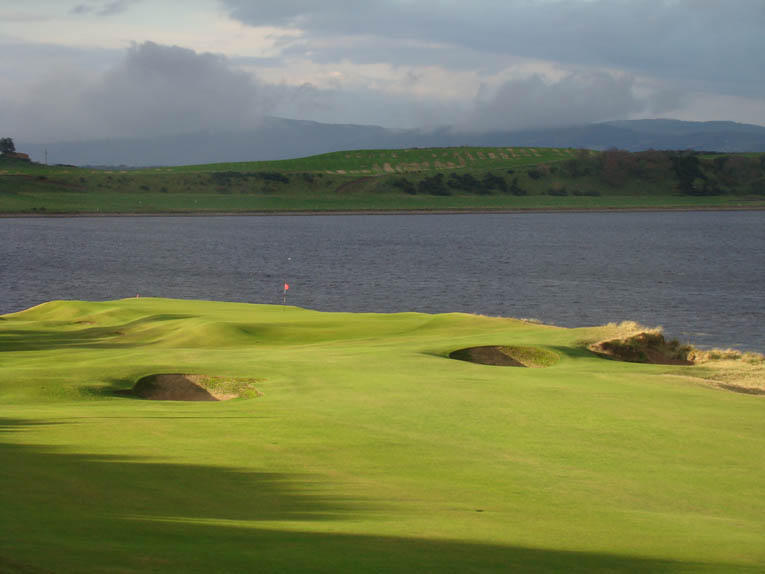
Vistas of the long and ever narrowing third green with the Moray Firth beyond are majestic. Hitting – and holding – the proper section of the green from any distance is deeply gratifying.
Fourth hole, 190/175 yards; Rarely is there cause for celebration when the golfer turns away from water yet it occurs twice at Castle Stuart, here and again at thirteen. Though the fourth has very fine playing qualities, the dominant feature is Castle Stuart and its open spire. Built in 1625, the edifice precedes by 120 years the Battle Of Culloden, which was fought nearby.
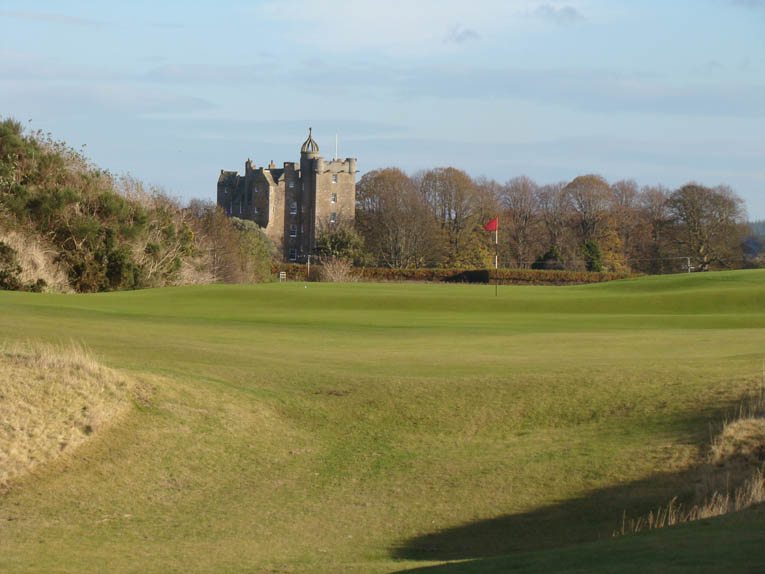
The fourth plays between dunes to an elevated green with the most difficult hole locations found on an upper plateau.
Fifth hole, 445/430 yards; One joy/benefit of links golf is how wildly different the same hole can play under different conditions. Downwind, a slope in the fifth fairway scoots balls forward to where a short iron gets the job done but against the wind, the golfer will greatly appreciate that the green was left open in front for the long iron that will likely be required. Inland holes rarely encompass such a 6 or 7 club difference.

Tweaking continues at Castle Stuart. These two pot bunkers seen long right at the 360 yard mark from the tee were added after studying play for two years. Castle Stuart’s firm running conditions are such that the pair are in play on downwind days.
continued >>>
Castle Stuart Golf Links
Inverness, Scotland, United Kingdom
Sixth hole, 560/520 yards; Straightaway, each shot gets progressively tougher with the screws applied at the green where some of the most vertical bunkers on the course chew into either side. While the professionals have fared well with this hole at three Scottish Opens held here, it needs to be noted that the wind only blew for two of the eleven rounds. The author looks forward to the return of the Scottish Open here in 2016 – and for some windier conditions when holes like this take on an entirely different character.
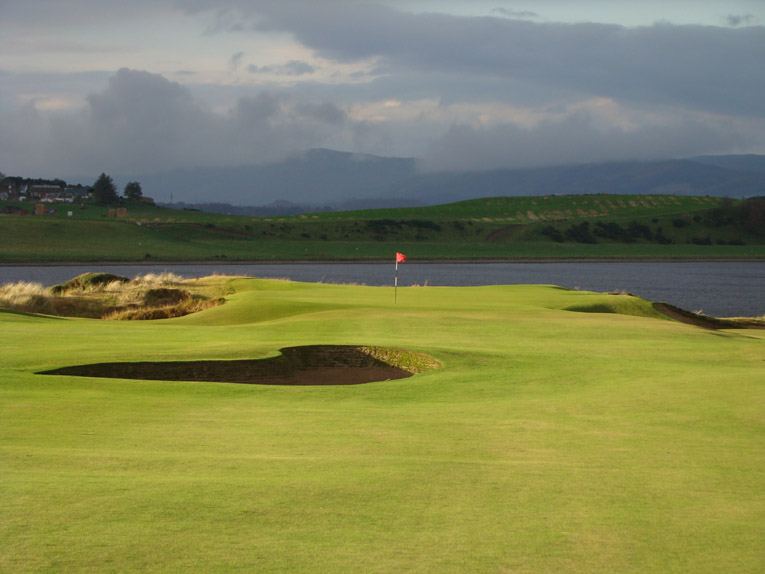
Stylistically, the design team decided that bunkers surrounded by short grass would present clean, crisp hazards, like this one 50 yards from the front of the sixth green.

… and right is worse! You may get near the green in two blows but securing birdie is far from given.
Seventh hole, 460/450 yards; The mark of any great design is how often the golfer must play it to appreciate its subtlety. If he can do so the first time, then the course assuredly lacks enduring merit. The longer the learning curve, the better because a golfer approaches each round with a new eagerness. So it is with this hole where the natural tendency is to shy away from the fierce drop-off and hazards left only to realize how approach shots played from the right side of the fairway are shunted away by broken ground in front of the green.

The seventh fairway swings around this fierce hazard. A fine view of the green and the ideal approach angle is afforded only those who position their tee ball near it.
Eighth hole, 220/210 yards; Surely the set of one-shotters here deserve mention among the best in the world. The uphill fourth, the sunken green here at the base of a hill, the downhill eleventh against the firth and the ground-hugging long seventeenth provide variety beyond reproach. On the November day that the picture below was taken, the hole played downwind, requiring a shot to land some thirty yards short of the putting surface. The tee ball went up and over the mound before the flag, out-of-sight … wait … and re-emerged on the far bank, before falling backwards toward the hole. The exact fate of the tee shot was unknown for most of the tee-to-green walk. That anticipation made the exactitude of American golf pale in comparison.
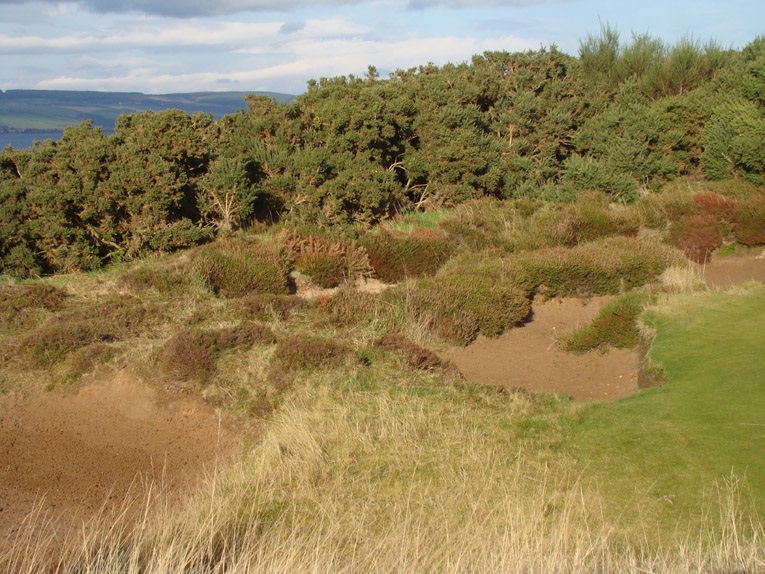
The nest of bunkers left of the eighth green is one of the most attractive hazards on the course. Narrow and odd shaped, neither a backswing nor follow-through is guaranteed. Given that the green is open, no golfer should ever find himself here.
Ninth hole, 365/350 yards; Intermediate holes need to have punch or the good player relentlessly exploits them. Water is the obvious but boring crutch that this design team mercifully eschewed. Instead, a two-tiered fairway and a wicked false front create the tension. The fairway appears ample but its right third is well below the putting surface. A subtle front right knob that slopes left makes approaches played from the right problematic. The sight of an under-struck ball that hits on the putting surface only to be whisked backwards into the short front bunker is demoralizing. Once seen, the player readily cedes this hole the respect it deserves because no one, absolutely no one, likes a 40-50 yard bunker shot. All told, the ninth is another example of how a hole with width can still demand precision.

The ninth green is the smallest target on the course, and it plays even smaller thanks to its dramatic false front.
Tenth hole, 405/360 yards; Golfers yearn to return to golf alongside a body of water. That’s true here but the merits of the last several high plateau holes are such that the author finds the return to be more pleasant than necessary. As the right handed golfer shies away from the firth with his tee ball, several design features conspire against him. His angle of approach worsens, the ball hangs above his stance promoting a pull, and the high right side of the green does all it can to shove balls hard left.

The well-situated tenth, eleventh and twelfth holes are certainly an enticing way to commence the inward nine.

The golfer’s tee ball curled past the well-positioned pot bunker some 90 yards from the middle of the green. He still faces a difficult angle.
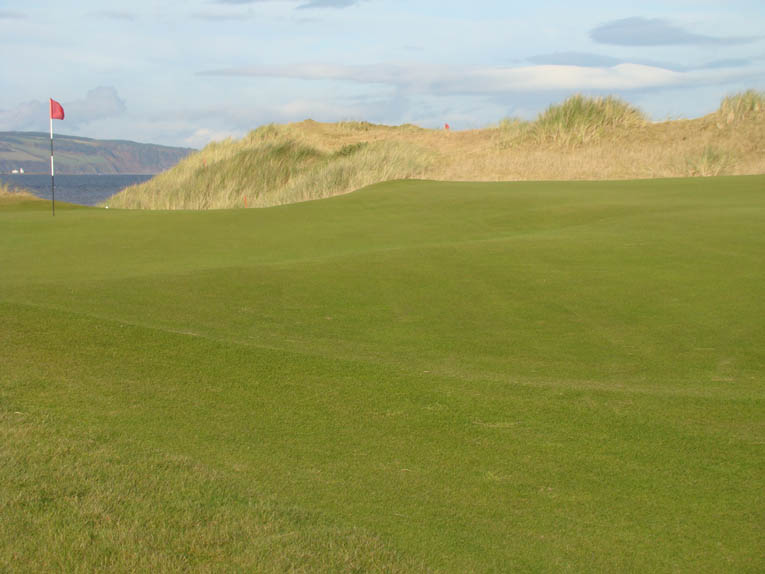
This ground picture highlights the pronounced but graceful green contours that divide the green into upper right and lower left sections.
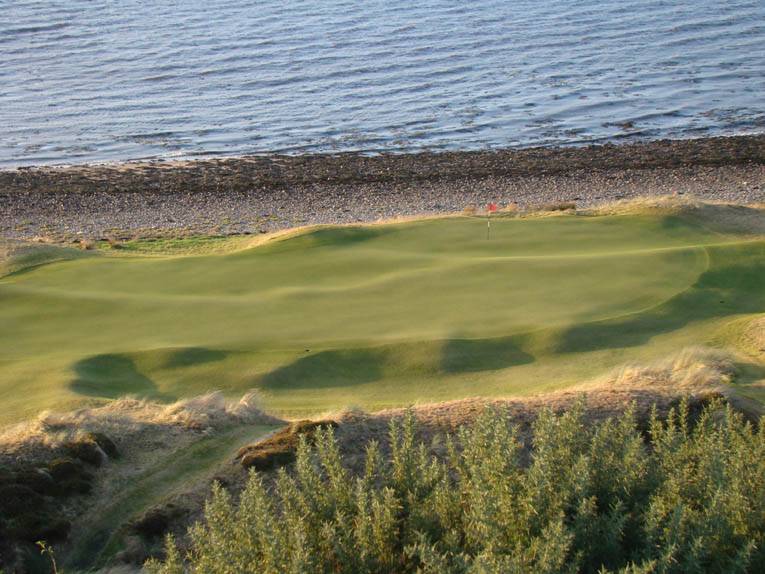
An overhead view provides a different – and illuminating – perspective of the spine that bisects the tenth green.
Eleventh hole, 145/130 yards; Examining a series of scenarios is the best way to understand the care that was taken to create flexibility within this design. On this hole, forward hole locations are worrisome as the green is narrow in front and the steep revetted bunker doesn’t portend an up and down. Nonetheless, the tiger grinds away in expectation of a birdie, given the hole’s modest length. Should the lesser player’s tee ball peel right with the prevailing wind and end up on the tight fescue right of the green, he does well to avail himself of the tightly mown mound, which can now serve as a backboard behind the hole. Lots and lots of ways to use it for working a recovery shot if you keep your wits. Such features are laced around the course and the shots they inspire are slowly revealed to the golfer over a series of rounds. The important thing is that they exist – and that makes the course a delight to understand.
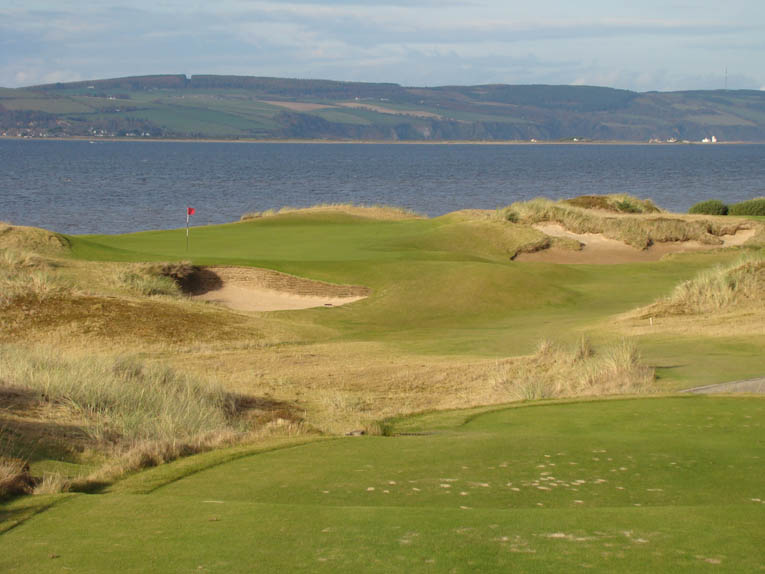
As seen from the tee, there is a lot more going on at the beguiling eleventh than most golfers first discern.
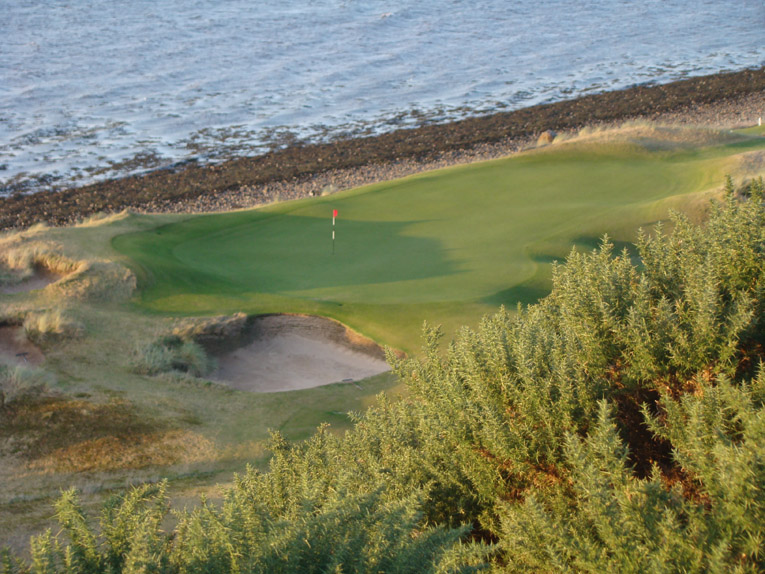
This aerial view captures the angle of the green hard against the shoreline. A slight pull is no friend to the right handed player.
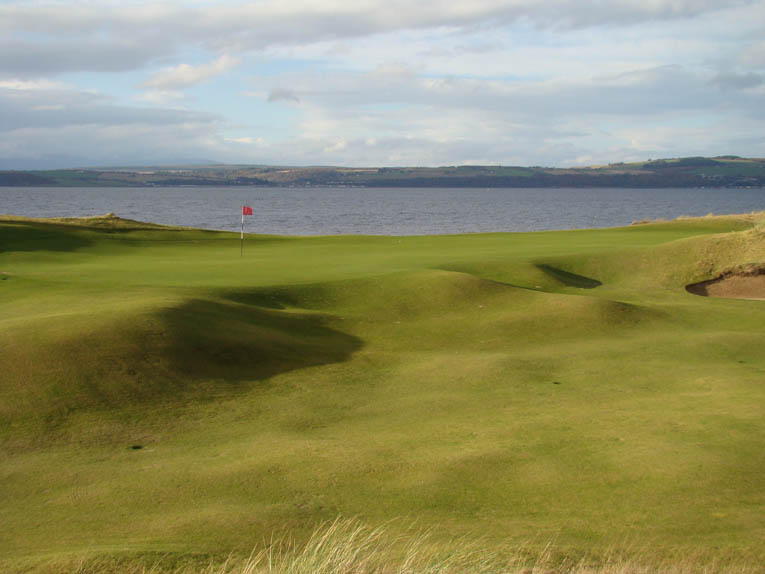
An entirely different play can be made from the short grass right of the green, especially if used in concert with the mound left of the flag.
Thirteenth hole, 440/415 yards; This was an important hole to get right. The golfer has just played the long uphill par 5, no one’s favorite hole, and he now climbs further uphill. To justify the trek the golf needs to be inspiring – and it is. The drive over the steepest valley on the course is pleasant enough but the approach is the real surprise. Defying convention, the golfer turns his back to the water on the tee and then surprisingly reacquaints himself with it and the Kessock Bridge at the green. Unsentimental old troopers who are more impressed by ground playing features in front than by distant views will be mightily impressed by the little ripples in the fairway and especially the field of crumpled ground near the green. Haspell details how those exquisite contours came to be:
Simple really, we would visit other links courses, play golf even just go for a walk, get the picture in our minds of the random nature that is rumple then we would shape with different width knuckle buckets on 2, 7 or 13 tonne 360 machines. You cannot do it with a dozer, it just does not work the same. We tried but it did not work as well, our method gave the difference in scale. Jim Wagner and I did most of it and I think it helps that two different people do it as nothing gets repeated. It certainly takes a while to mimic nature but I hope we got away with it. Some of my friends in the industry joke that we spent more time shaping fairways and even some roughs to get the aged effect than most people spend on greens and surrounds, all of which were finished by hand to produce the desired result.

Are these landforms not gorgeous?! All the lessons learned at Kingsbarns coupled with the talents of Hanse and Wagner were brought to bear at Castle Stuart.
continued >>>
Castle Stuart Golf Links
Inverness, Scotland, United Kingdom
Fourteenth hole, 385/360 yards; Devious and difficult, the golf simply must be played down the left side of the fairway. Sneakily, a mound off the tee obscures how generously the fairway extends to that side. Far too many golfers inadvertently head down the middle or right side of the fairway and find themselves confounded by an oblique approach into the long, narrow green that slopes away. Parsinen’s article in the February, 2014 Executive Golfer ‘Can a Straightaway 386 yard par 4, with a 50 Yard Wide Fairway and Only One Small Bunker in Play Be Worthy of Interest?’ says it all. Only those who haven’t played it consider it a birdie hole!
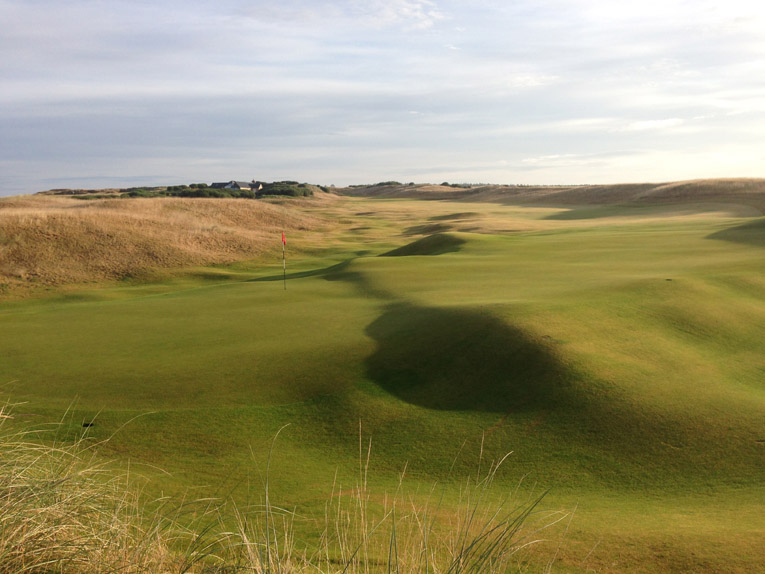
As seen from behind, the angle of the green to the fairway and the ‘s’ drop in the front to back sloped green conspire to give all players fits.
Fifteenth hole, 420/ 410 yards; A handful of professional golfers that played in the Scottish Opens here sniffed that the course is a bomber’s paradise because the fairways are so wide. The ignorance of their comments is bemusing. At Castle Stuart, we see only intelligent width, that which affords an advantage by playing to certain sections of the fairway. Castle Stuart was designed with options in mind and the savvy golfer exploits the width to benefit his approach. The author applauds 2013 Scottish Open winner Phil Michelson who opined that every golf architect should come here to understand how courses should be built.
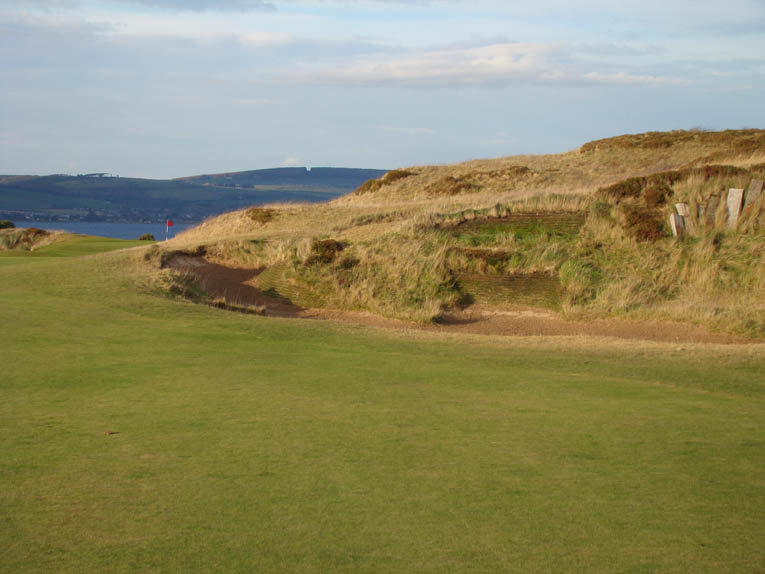
An approach shot played from the right must carry the fierce embankment 80 yards short of the green. Meanwhile, approach shots played from the left …
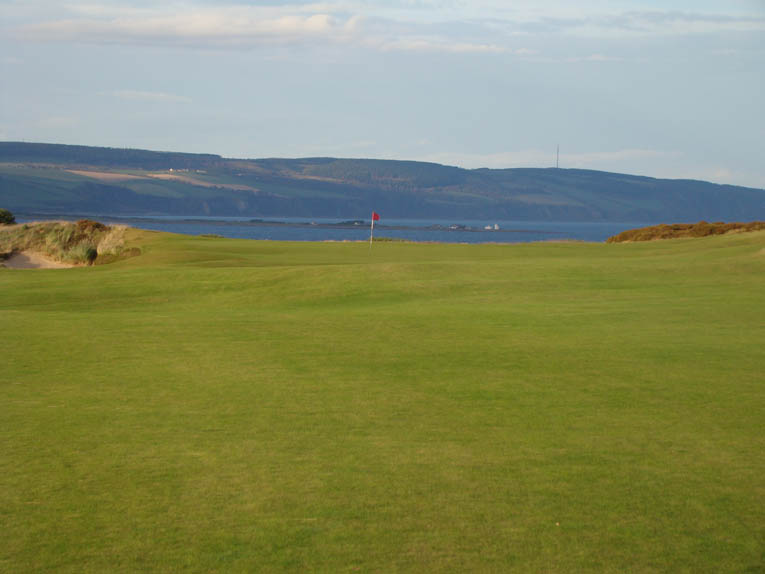
… offer a more enticing prospect. This is yet another example of how a 50 yard wide fairway is cut in half in terms of an optimal hitting area.
Sixteenth hole, 335/325 yards; A supreme example of ‘less is more’ architecture, the golfer stands on the tee and sees nothing but acres of friendly short grass in front of him. With no apparent trouble, the golfer is wooed onward, having a slash at the green. Then … issues! Driving too close to the green as well as driving over it lead to all sorts of squirrelly positions. The fact that the domed, angled green is the highest, most exposed point on the property portends difficulty in controlling one’s ball in a normal two club wind. Perhaps the sweeping views from the green will provide solace because nothing else will. Over time the golfer will learn a variety of the ways to deal with this testy, tiny terror, including restraint from the tee.

The oft-visited bowl front left and the heavily trafficked two rear right bunkers instill ample defense to this angled green.
Seventeenth hole, 225/210 yards; Many designers talk about ground game options but few deliver and even fewer actually do so meaningfully. For instance, providing a sidekick just left of a green is nice but usually the golfer can just as easily aim for the middle of the green. Here, the architects massaged the land twenty yards short of the putting surface to wonderfully expand the range of shots available. This is especially apropos at a windy site. Watching a ball catch the subtle left to right slope and feed onto the green is one of the most rewarding shots at Castle Stuart. Such slow developing scenes are a delightful reminder that golf is most enjoyed along the ground.
Eighteenth hole, 595/510 yards; This hole joins the Home holes at the Plantation Course at Kapalua and Cabot Cliffs as the author’s three favorite finishing holes built since World War II. All are three-shotters that promote a huge range of outcomes thanks to their topography and shrewd design. All three possess in spades a sense of excitement and the joy of being alive that comes from playing downhill amid stirring panoramic vistas. This hole perfectly encapsulates Parsinen’s goal of golf that promotes ‘an expansive mindset’; the views each step of the way fill every golfer with hope. The golf is excellent and the land is such that the tiger can continually seek an advantage. Perhaps he can use the fairway contours to propel his ball forward until it reaches a flat spot from where he can go for the green in two? The rest of us tack our way down, and if we stumble, there generally exists the ability for recovery and redemption as enunciated by Parsinen in the yardage book.
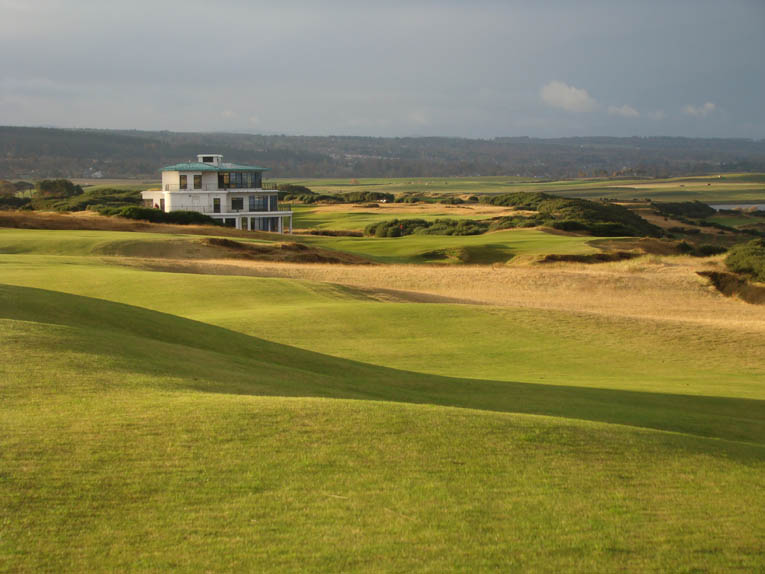
The morning sun accentuates the fairway contours that were coaxed out of the ground during construction.

Note the depression along the left side of the green that complicates matters for those who approach from that side.
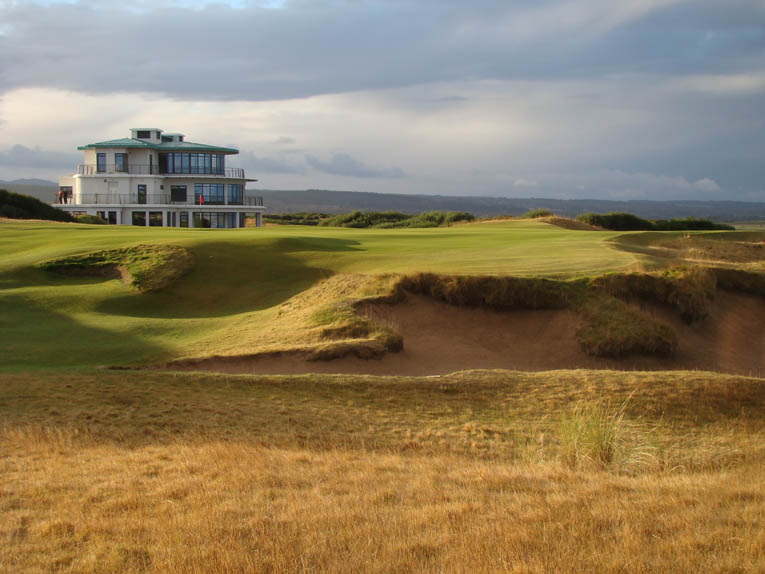
Few better places exist for shaking hands after a well-fought tussle than the rolling Home green at Castle Stuart.
We have gone too long without commenting on the distinctive art deco inspired clubhouse, a style born during the Golden Age of golf course architecture. Initially polarizing à la Royal Birkdale’s clubhouse that broke new ground from the traditional, boxed slate roofed building, this unique structure on the Scottish landscape has turned doubters into admirers in a few short years. Its interior is expertly laid out for efficiency and the floor to ceiling glass enables spectacular views from the semi-circular lounge. The professional shop is perfectly positioned so that visiting golfers are promptly greeted and so that the practice area can be monitored. To the author, the clubhouse’s singular style is the perfect fit for such an original course design.
Given that land easily accessed that is also ideal for golf is almost impossible to come by, Castle Stuart provides hope that vision, brainpower, and in-the-dirt talent will yield courses that can compete with the best. Of course, some travelers to the United Kingdom desire to play only courses designed by architects long dead. Such a simplistic approach has served golfers well but now it’s a serious mistake. For width, strategy and enjoyment, the author puts Castle Stuart on par with Royal Dornoch a little farther north – you wouldn’t dream of skipping that course, would you?





